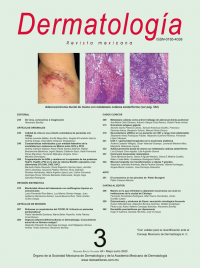Clinical effectiveness of topical antifungal treatment in onychomycosis.
Dermatol Rev Mex. 2020 mayo-junio;64(3):270-286.
Luisa Fernanda Ríos-Barco,1 Luz Marina Gómez-Vargas,1 Juan Guillermo Barrientos-Gómez,2 Laura Becerra-Ruiz,3 Yerlin Andrés Colina-Vargas3
1 Dermatóloga.
2 Médico. Magíster en Investigación Sociosanitaria. Clínica Universitaria Bolivariana.
3 Médico.
Universidad Pontificia Bolivariana, Medellín, Colombia.
Resumen
ANTECEDENTES: La onicomicosis es la infección de las uñas por hongos dermatofitos, levaduras o mohos no dermatofitos. Se asocia con alta tasa de fracaso terapéutico (20-50%) debido a la resistencia a los diferentes agentes terapéuticos.
OBJETIVO: Realizar una revisión sistemática de la bibliografía para establecer la efectividad clínica de los antifúngicos tópicos para tratar la onicomicosis.
MÉTODO: Revisión sistemática de la bibliografía; se incluyeron artículos originales en inglés, español y portugués, entre 1999 y 2016 de cinco bases de datos indexadas.
RESULTADOS: Se incluyeron ocho estudios calificados con riesgo bajo e indeterminado de sesgos y se realizó un resumen cuantitativo de los resultados: la efectividad clínica fue mayor en el grupo ciclopiroxolamina laca hidrosoluble a 8% vs el grupo de amorolfina laca a 5% con duración de tratamiento entre 9 y 12 meses, al igual que en el grupo efinaconazol solución tópica a 10% vs placebo cuyo tiempo de tratamiento fue de 12 meses y en el grupo tavaborole solución tópica a 5% vs placebo por 12 meses.
CONCLUSIONES: Ante la afectación de la lámina menor a 60%, en pacientes sin inmunosupresión, la ciclopiroxolamina laca hidrosoluble a 8% es superior a la amorolfina laca a 5% y efinaconazol solución a 10% y tavaborole solución a 5% son superiores al placebo; sin embargo, las tasas de curación completa encontradas no fueron mayores de 40% en ningún estudio durante un tiempo de tratamiento máximo de 12 meses.
PALABRAS CLAVE: Onicomicosis; antifúngicos; antiinfecciosos locales.
Abstract
BACKGROUND: Onychomycosis is the infection of the nails by fungi, dermatophytes, yeasts or non-dermatophyte molds. It is associated with a high rate of therapeutic failure (20-50%) due to resistance to different therapeutic agents.
OBJECTIVE: To perform a systematic review of the literature to establish the clinical effectiveness of topical antifungals to treat onychomycosis.
METHOD: A systematic review of the literature was carried out; original articles were included in English, Spanish and Portuguese, between 1999 and 2016, in five indexed databases.
RESULTS: Eight studies were included, classified with a low and indeterminate risk of biases, and a quantitative summary of the results was made: the clinical effectiveness was higher in the 8% water soluble cyclopiroxolamin group vs the 5% amorolfine group with a duration of treatment between 9 and 12 months), as well as in the group of 10% topical efinaconazole solution vs placebo whose treatment time was 12 months and in the group of tavaborole topical solution at 5% vs placebo for 12 months.
CONCLUSIONS: When the lamina is less than 60% compromised, in patients without immunosuppression, 8% water soluble cyclopiroxolamin lacquer is superior to 5% amorolfine lacquer, and efinaconazole solution at 10% and tavaborole topical solution at 5% are superior to placebo; however, the complete cure rates found were not greater than 40% in any study, during a maximum treatment time of 12 months.
KEYWORDS: Onychomycosis; Antifungal agents; Local anti-infective agents.

